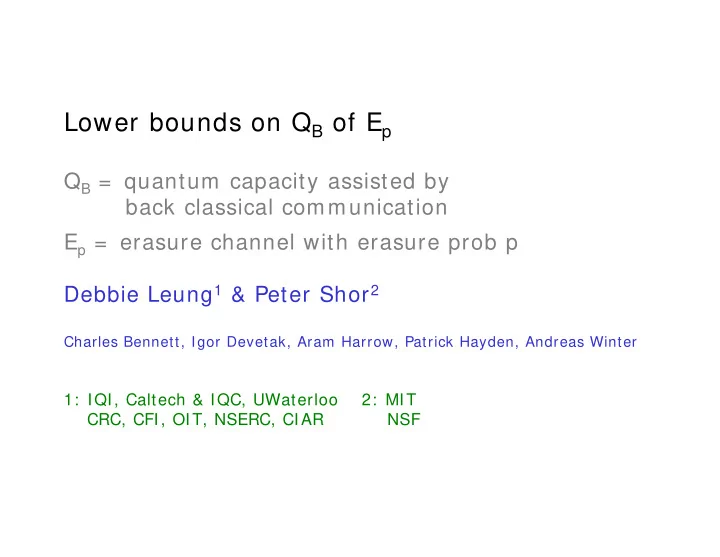

Lower bounds on Q B of E p Q B = quantum capacity assisted by back classical communication E p = erasure channel with erasure prob p Debbie Leung 1 & Peter Shor 2 Charles Bennett, Igor Devetak, Aram Harrow, Patrick Hayden, Andreas Winter 1: IQI, Caltech & IQC, UWaterloo 2: MIT CRC, CFI, OIT, NSERC, CIAR NSF
Q B : Quantum capacity assisted by back classical communication ρ in local op local op Alice ... N N Bob local op local op ρ out • Asymptotic ability to send quantum data: large # uses, high fidelity, entanglement preserving, unlimited local ops • Unlimited back classical comm (quantity & # rounds)
E p : Erasure channel with erasure prob p with prob 1-p : with prob p : ρ (viewed as Eve getting ρ ) ρ ρ good bad Obvious “resource inequalities” (Devetak-Harrow-Winter) E p + cbit ← ≥ (1-p) ebit SP: Use E p to send ebits (+ Bob telling Alice Good/ Bad @ time) CC: E p + cbit ← ≥ (1-p) cbit → Use E p to send cbits (+ feedback) Omit free cbit ← from now on ... If you care, augment @ E p with cbit ←
Post-presentation editing: Previous slide: E p ≥ (1-2p) qbit → w/ o back comm E p ≥ (1-p) ebit SP: E p ≥ (1-p) cbit → CC: S ⊂ { Bennett, DiVincenzo, Wootters, Smolin} - 95/ 96 Original protocol / lower bound for Q B (E p ) Using TP: 1 ebit + 2 cbit → ≥ 1 qbit → (Teleportation) ∴ E p ≥ (1-p)/ 3 qbit → Idea of the new protocol (coined by Harrow) : don’t do anything you’ll regret
Regret what ? cbit: | x i A → | x i E ⊗ | x i B Harrow 03 cobit: | x i A → | x i A ⊗ | x i B cf qbit: | x i A → | x i B e.g. TP co : 1 ebit + 2 cobits ≥ 1 qbit + 2 ebits ! Proof: ρ x ∈ { 0,1,2,3} ∑ x | x i A | x i B 0 ρ σ x
Regret what ? cbit: | x i A → | x i E ⊗ | x i B Harrow 04 cobit: | x i A → | x i A ⊗ | x i B e.g. TP co : 1 ebit + 2 cobits ≥ 1 qbit + 2 ebits ! or TP co : 2 cobits ≥ 1 qbit + 1 ebit SD: 2 cobits · 1 qbit + 1 ebit Also: so 2 cobits = 1 qbit + 1 ebit
In hindsight ... in teleportation protocol for previous lower bound of Q B , should have exploited coherence in the classical comm generated by E p classical comm via E p can be made coherent-conditioned-on-“Good” x x 0 x E p But we don’t know which one is Good/ Bad upfront ...
Method 1: Try using E p to send x in TP as cobits. If either is “Bad”, try sending again, now as a cbit . E p ≥ (1-p) 2 cobit + (1-p) p cbit Proof: Prob Cost Yield (1-p) 1 E p 1 cobit (1-p) p 2 E p 1 cbit (1-p) p 2 3 E p 1 cbit ... ∴ (1-p) (p + 2p + 3p 2 + ...) E p ≥ (1-p) cobit + p cbit
Method 1: Try using E p to send x in TP as cobits. If either is “Bad”, try sending again, now as a cbit . E p ≥ (1-p) 2 cobit + (1-p) p cbit If p ≥ ½ , rearrange using 2 cobits = ebit + qbit 1 ebit + 2 cbits ≥ 1 qbit E p + cbit ← ≥ (1-p) ebits 1 − p qbit → E p ≥ 1+ 2p
Method 2: Staying “coherent” in the presence of uncertainty SD via E p : 1 ebit + E p ≥ (1-p) 2 cobits Proof: x ∈ { 0,1,2,3} σ x Alice σ x .... E p E p x Bob σ x Eve’s
Method 2: Staying “coherent” in the presence of uncertainty SD via E p : 1 ebit + E p ≥ (1-p) 2 cobits Proof: x ∈ { 0,1,2,3} Alice σ x .... E p E p x Bob Eve’s Just an ebit between Bob and Eve
Method 2: Staying “coherent” in the presence of uncertainty SD via E p : 1 ebit + E p ≥ (1-p) 2 cobits TP co : 1 ebit + 1 ebit + E p ≥ 1 qbit → + 2 ebits 1-p rearranging, and using SP: E p ≥ (1-p) ebits E p ≥ (1-p) 2 qbit →
Summary of lower bounds for Q B (E p ): 1 0.9 Best upper bound 1-p 0.8 Q 2 ≠ Q B ?? 0.7 0.6 (1-p) 2 Q B Q B 0.5 0.4 1-2p Current 1 − 0.3 p 1+ 2p 0.2 Previous ( 1 - p ) / 0.1 3 0 0 0.1 0.2 0.3 0.4 0.5 0.6 0.7 0.8 0.9 1 p p
Further work • Simple generalization: - Phase erasure/ mixed erasure channels - dimension > 2 - remote state preparation • Current method as secret sharing schemes. - generalization gives worse results. -
Recommend
More recommend